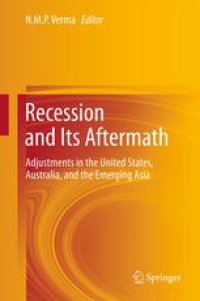
Ebook: Recession and Its Aftermath: Adjustments in the United States, Australia, and the Emerging Asia
- Tags: Macroeconomics/Monetary Economics, Financial Economics
- Year: 2013
- Publisher: Springer India
- Edition: 1
- Language: English
- pdf
Market failure at medium intervals is inevitable in a capitalist economy. Such failures may not be seriously seen in the short run because market adjusts demand through hoarding of inventory or import of required goods and services. The market also adjusts demand in the long run through expansion of concerned industrial output and also by the entry of new firms. The crucial variable is price which also adjusts the commodity and the labor market. The problem comes when there are issues of overproduction, over capacity utilization of plants, over liquidation and excess supply of money, change in demand because of change in tastes and habits of consumers, households and the public. All these create knife edge disturbances in the economy. As a consequence they need adjustment through some variables such as employment and growth of population, saving propensity, technology, exhaustion of existing inventory, monetary and fiscal balancing. In this volume an attempt has been made to appraise the working of a market economy where short term disturbances may occur, market efficiency reduces, recessionary cycle emerges and after certain fundamental measures the market recovers. Starting with a brief recent history of the crisis and the recession, discussions in this volume turn to how deliberations in macroeconomics yield implications for specific policies, some of which have been tried and others still to be tested. Further in the volume we propose policies necessary for efficient regulation of the economic system, and give a brief assessment of the extent to which global policy coordination has been mulled in policy circles even if these are not seriously practiced.
Market failure at medium intervals is inevitable in a capitalist economy. Such failures may not be seriously seen in the short run because market adjusts demand through hoarding of inventory or import of required goods and services. The market also adjusts demand in the long run through expansion of concerned industrial output and also by the entry of new firms. The crucial variable is price which also adjusts the commodity and the labor market. The problem comes when there are issues of overproduction, over capacity utilization of plants, over liquidation and excess supply of money, change in demand because of change in tastes and habits of consumers, households and the public. All these create knife edge disturbances in the economy. As a consequence they need adjustment through some variables such as employment and growth of population, saving propensity, technology, exhaustion of existing inventory, monetary and fiscal balancing. In this volume an attempt has been made to appraise the working of a market economy where short term disturbances may occur, market fails, recessionary cycle emerges and after certain fundamental measures the market recovers. Starting with a brief recent history of the crisis and the recession, discussions in this volume turn to how deliberations in macroeconomics yield implications for specific policies, some of which have been tried and others still to be tested. Further in the volume we examine policies necessary for the regulation of the economic system and give a brief assessment of the extent to which global policy coordination has been discussed in policy circles even if not seriously practiced.
Market failure at medium intervals is inevitable in a capitalist economy. Such failures may not be seriously seen in the short run because market adjusts demand through hoarding of inventory or import of required goods and services. The market also adjusts demand in the long run through expansion of concerned industrial output and also by the entry of new firms. The crucial variable is price which also adjusts the commodity and the labor market. The problem comes when there are issues of overproduction, over capacity utilization of plants, over liquidation and excess supply of money, change in demand because of change in tastes and habits of consumers, households and the public. All these create knife edge disturbances in the economy. As a consequence they need adjustment through some variables such as employment and growth of population, saving propensity, technology, exhaustion of existing inventory, monetary and fiscal balancing. In this volume an attempt has been made to appraise the working of a market economy where short term disturbances may occur, market fails, recessionary cycle emerges and after certain fundamental measures the market recovers. Starting with a brief recent history of the crisis and the recession, discussions in this volume turn to how deliberations in macroeconomics yield implications for specific policies, some of which have been tried and others still to be tested. Further in the volume we examine policies necessary for the regulation of the economic system and give a brief assessment of the extent to which global policy coordination has been discussed in policy circles even if not seriously practiced.
Content:
Front Matter....Pages i-xx
Understanding Recession: Conceptual Arguments and US Adjustments....Pages 1-22
The Financial Crisis and the Great Recession in the United States....Pages 23-45
Dynamics of Deflation and Unemployment: Fall into an Abyss of Depression....Pages 47-66
Market Fluctuations and Country Risk Relationships for Australian and Indian Energy....Pages 67-80
The Chinese Economy After the Global Crisis....Pages 81-111
The Role of Macroeconomic Fundamentals in Malaysian Post Recession Growth....Pages 113-127
Impact of Global Financial Crisis on Economic Wellbeing: A Case of South Asia....Pages 129-155
The Asian Economic Crisis and Malaysia’s Responses: Implications for the Banking Sector....Pages 157-177
Output Growth in Post Liberalized India: An Input–Output Structural Decomposition Analysis....Pages 179-213
The Recent Recession: Impact and Future Prospects for the Indian Banking Sector....Pages 215-231
Impact of the Global Downturn on the Indian Economy....Pages 233-255
Back Matter....Pages 257-267